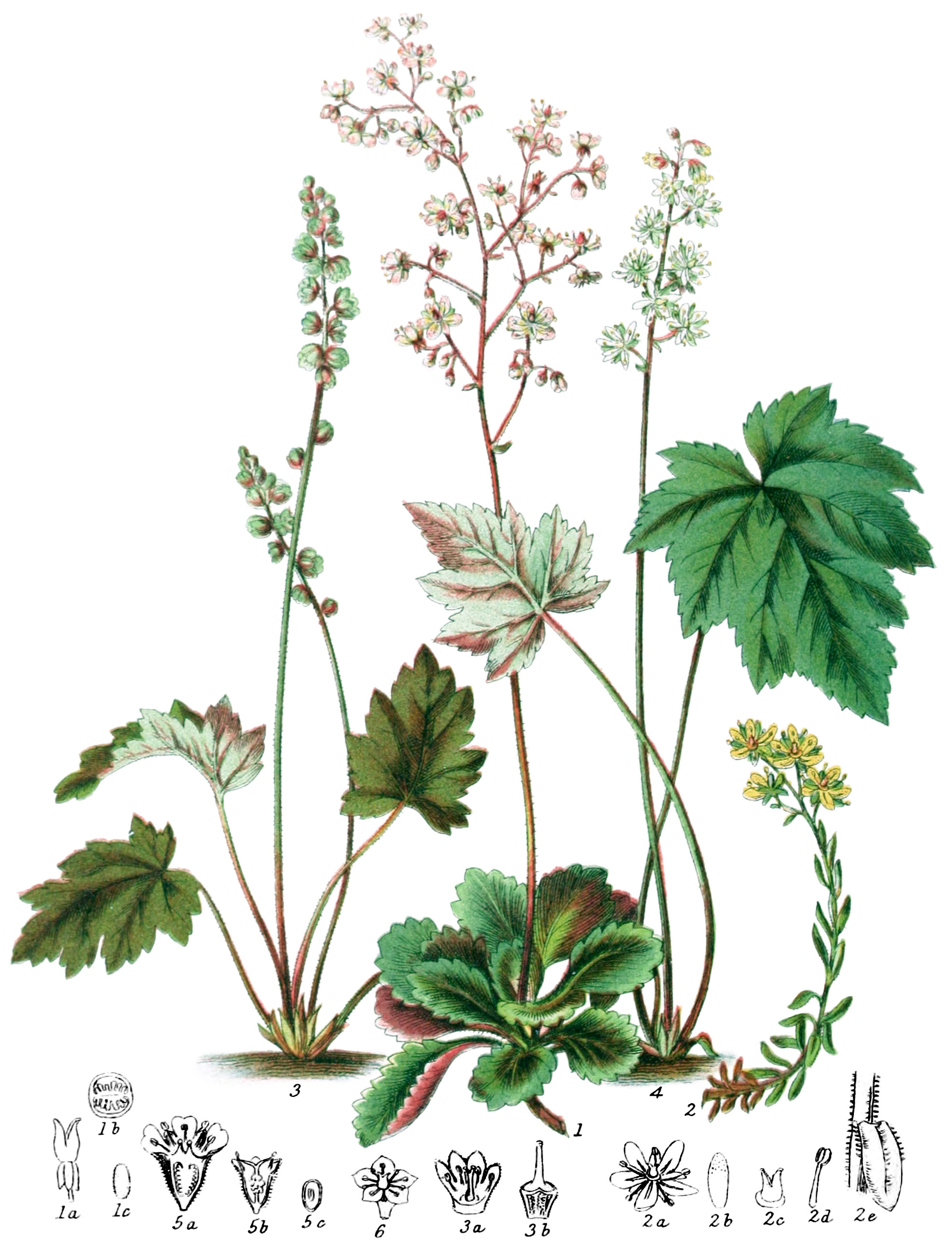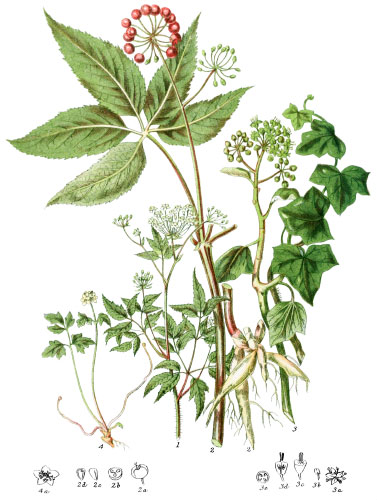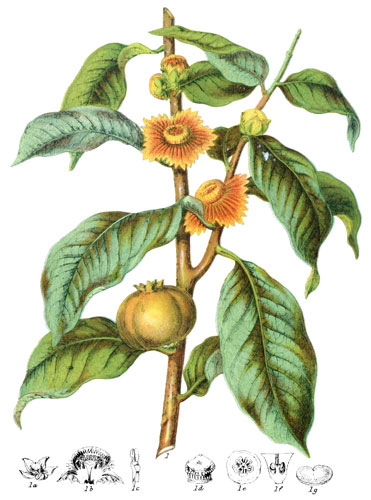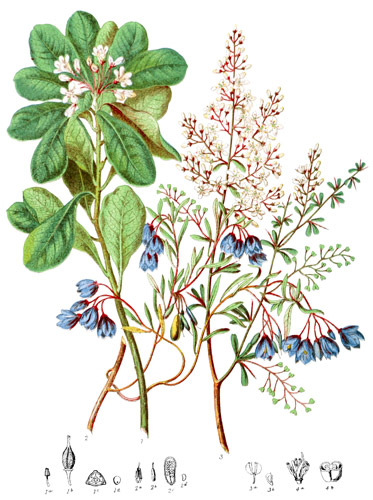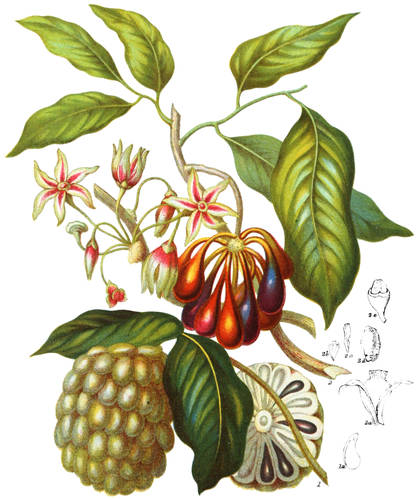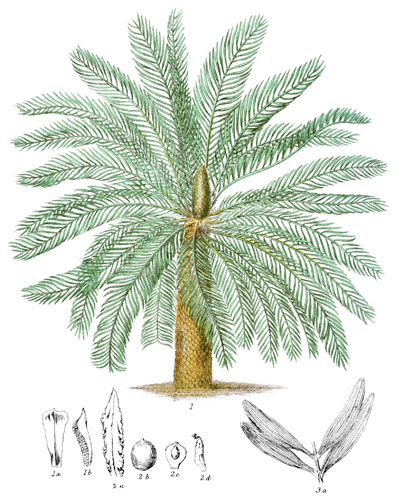Key characteristics
Herbaceous plants, nearly all of which are perennial, having fibrous or granular roots, often growing in spreading patches; the leaves are either whole at the edges or divided, alternate, with or without stipules. The flower-stems are simple, usually without leaves; the calyx is either above or below the ovary, and has four or five sepals, which are united more or less at their base. The petals are five, or wanting as in Chrysosplenium (6), inserted between the lobes of the calyx, or beneath the ovary. The stamens are either five in number and alternate with the petals, or they are ten, five usually of a smaller size and later in arriving at perfection, being opposite the petals; the filaments are awl-shaped, fixed to the calyx, or beneath the ovary; the anthers are two-celled, bursting either by pores or chinks lengthwise. The disk is sometimes obsolete, sometimes annular or notched, rarely composed of five scales. The ovary is composed usually of two carpels, cohering more or less, diverging at the top; sometimes two-celled, with a central column, sometimes one-celled, having a projection on which the seeds are placed, at each seam of the carpels. The styles are in some cases nearly obsolete, the stigmas being on the tips of the carpels. The fruit is a membranous capsule, the cells separating when ripe; the seeds are numerous, very minute, containing fleshy albumen, usually with long hexagonal reticulations on the transparent covering.
These plants have close affinity with the Rose tribe, but are distinguished by the partially united carpels, and the seeds containing albumen.
Slightly astringent properties exist in some of the plants of this tribe.
Select plants in this order
Not all plants listed are illustrated and not all plants illustrated are listed.
- Saxifraga is an extensive genus, widely dispersed over the temperate or cold regions of the globe, growing chiefly on mountains, and there frequently spreading over the ground to a considerable extent, many of the species having runners from which fresh plants proceed. When it is found in lower situations, it is usually along the rivers which descend from mountains or hills; in the most northern countries it exists on the level plains, finding there a temperature and soil as favourable as on the lofty parts of warmer regions.
- The Polar region has been dominated that of Saxifrages and Mosses, those plants being the most numerous representatives of the two great classes of vegetable kingdom, in that portion of the world.
- Saxifraga oppositifolia, cernua and rivularis of Britain and Switzerland, grow on the plains of Melville Isle, as well as in Iceland.
- S. bryoides, aspera, cæspitosa, sedoides, and others, are found amongst the small plants which ascend to the region of snow on the Swiss Alps, between 7000 and 9000 feed.
- S. imbricata, ramulosa, and species of similar Alpine character, grow on the Himalayas, above 11,000 feet, in situations where the climate very nearly resembles that of the Polar regions.
- Some kinds of Saxifrage have been observed at an elevation of 13,000 feet on the Andes.
- S. umbrosa (1) is the most beautiful of our English species, found only rarely in a wild state, but a general favourite in gardens, thriving even in the smoky air of cities, whence the popular name of London Pride: it is, however, of superior brilliancy and beauty when seen in its native place, amidst the rocks of the stream which flows through Heselden Glen, in the Craven district of Yorkshire.
- S. aizoides (2) is very frequent on the margins of mountain rills, or in a peat soil, in Wales, Scotland, and Ireland: several other granules of the roots.
- S. tridactylites (5),* very common on old walls, wherever there is sufficient moisture, and on untrodden gravel walks, is one of the earliest plants of the year to attract the notice of a botanical student: the whole plant is covered with red granular hairs, worthy of microscopical examination.
- On descending the Simplon Pass into the valley of Ossola, one of the most striking objects on the rocks is S. pyramidalis; this graceful species is seen also in the far north, on the rocks which bound the Fiords of Norway, in lat. 63°.
- S. crassifolia of Siberia is a well-known plant in the spring, adorning the gardens with its large oval leaves and fine branches of purple flowers.
- There is occasionally one plant in the natural order which forms an exception to the general character; in this instance S. sarmentosa of China furnishes an example of an irregular flower, two of the petals being much longer than the rest.
- Heuchera cylindrica (3) is one of a few species, all natives to North America; it is destitute of petals, of less beauty than many of the tribe.
- Tiarella (4) is said to have been named from the shape of the seed-vessel being like a tiara or mitre; Mitella has the same derivation of name: both belong to North America.
- Chrysosplenium (6) is scattered over Europe, and forms part of the scanty Flora of Melville Isle, consisting only of thirty species; the flowers are without petals, the calyx having a yellow hue; in the Vosges it is eaten as a salad.
Locations
This Tribe inhabits the mountainous tracts in Europe, the northern countries of Asia and North America; some species exist on the Andes of South America, and at the Straits of Magellan: none are natives of the Tropics.
Legend
- Saxifraga umbrosa, London Pride. England.
- Capsule.
- Section magnifield.
- Seed, m.
- Saxifraga aizoides, Yellow mountain Saxifrage. England.
- Flower.
- Petal, m.
- Pistil.
- Stamen, m.
- Leaf, m.
- Heuchera cylindrica. North America.
- Section of Flower, m.
- Section of Ovary, m.
- Tiarella cordifolia. North America.
-
- Section of the Flower of Saxifraga tridactylites, m.
- Section of Capsule, m.
- Section of Seed, m.
- Flower of Chrysoplenium, m.
*5 was mentioned in the original description but only 5a, 5b, and 5c were illustrated.
Explore more
Posters
Decorate your walls with colorful detailed posters based on Elizabeth Twining’s beautiful two-volume set from 1868.
Puzzles
Challenge yourself or someone else to assemble a puzzle of all 160 botanical illustrations.
